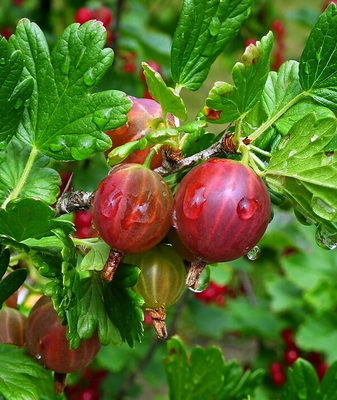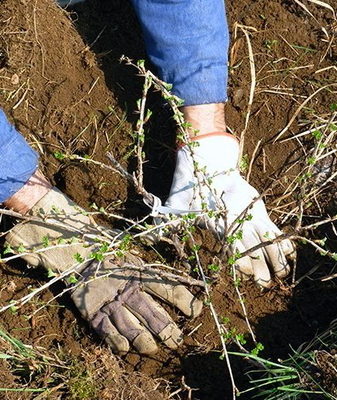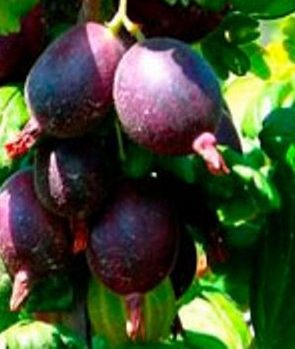Gooseberry English yellow
Content:
In this article, we will tell you about the English yellow gooseberry. We will give its description, main characteristics, talk about resistance to frost and drought. Let's talk about the yield and fruiting of this variety, and also note the main advantages and disadvantages. You will learn how to propagate the English Yellow gooseberry correctly, how to plant it and further care for it, how to grow it correctly, what diseases and insect pests are dangerous for it. We will also share the gardeners' feedback.
Gooseberry English yellow: variety description and characteristics
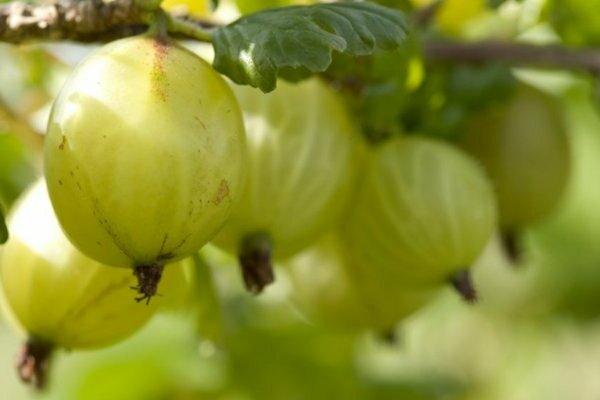
English yellow gooseberry: photo of the variety
Almost everyone is familiar and in love with a berry like gooseberry. Its sweet taste, "bursting" peel, thorns on the branches - all this is an integral part of the gooseberry.
When growing berries (in fact, like any other crop), we always give preference to those varieties that are less whimsical to grow, are resistant to various weather conditions, with a tasty and fruitful harvest.
If you are picking gooseberries, then this description is ideal for gooseberries such as English yellow gooseberries. In this article, we will talk about it in detail.
Gooseberry variety English Yellow is adapted for cultivation in the southern and central regions. If you plan to grow it in the northern and eastern regions, take care of the shelter of the plant in winter. And keep in mind that the yield level will be much lower.
- The bushes of the plant are erect, collapsed. Their height is about one and a half meters. This shape of the bush allows you to pick berries very quickly and easily.
- The gooseberry has an English yellow gray bark that gets darker with age. If the plant is more than 2 years old, then the skin turns brown. Shoots are thin enough. On them one can rarely find single, soft, rather long thorns.
- The foliage of the English yellow gooseberry is medium-sized, about 3 cm both in width and in length. It has a dark green color, but closer to autumn, the shade changes to purple.
- Gooseberry blooms at the end of May. The flowers are small - about one cm long, they have a yellow-white color.
- The English yellow gooseberry is a self-fertile variety. This suggests that there is no need for pollination.
I would like to draw your attention to the fact that ripe berries do not crumble, but hang on the branches until they are picked, which is a very big plus.
Drought and frost resistant
English yellow gooseberry frost-resistant. He tolerates winter normally, frosts are not terrible for him. If the region has a long, cold winter and if there is little snow, then the plant needs a mandatory shelter. Snowy winters with air temperatures down to -21 degrees are not dangerous for him.
The English yellow gooseberry variety is also resistant to drought, which allows the plant not to be watered often, waterlogging is more dangerous and more terrible for it than drought.
Productivity and fruiting
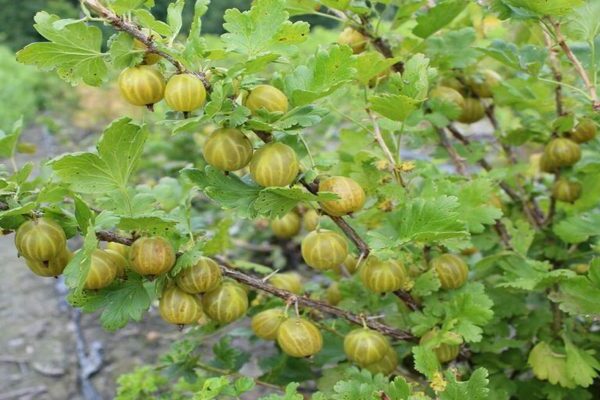
English yellow gooseberry: photo of the variety
Gooseberries are English yellow with a rich yellow color, have a small soft fluff. The berries weigh from 4 to 7 grams. When the berries are fully ripe, they have a golden glossy hue.
The berries are fully ripe in the middle of summer. The peel of the English gooseberry is quite soft. Their flesh is very sweet and has a yellow color. The fruits do not have a pronounced aroma, but they have a wonderful dessert taste.
The yield level of this variety is consistently high. All berries ripen together. Harvest twice. Under favorable conditions for growing berries, as well as observing certain rules, gardeners collect 1 bucket of gooseberries from one plant.
The harvested crop has a good keeping quality. And he is not afraid of transportation - while maintaining his original characteristics. Exposure to the sun does not affect its taste and quality characteristics.
The fruits of the English gooseberry are used in the preparation of amber wine. Many people like to eat straight from the branch - fresh, they are also used to make compotes.
Gooseberry variety English yellow: advantages and disadvantages
The berries of this type of gooseberry have a lot merits, which is very captivating for gardeners. As a result, this particular variety is chosen for cultivation.
- high, stable yield;
- great taste;
- good indicator of keeping quality;
- excellent presentation;
- berries tolerate transportation well without losing their original presentation;
- resistant to many diseases;
- comfortable compact bush shape, allowing you to harvest without hindrance.
Against the background of virtues, minuses are quite insignificant. Gardeners highlight the susceptibility of English gooseberries to American powdery mildew (spheroteka). And also with waterlogging - cracking of the peel is noted in the berries. Also, when berries are frozen, they lose their excellent taste.
How to propagate correctly
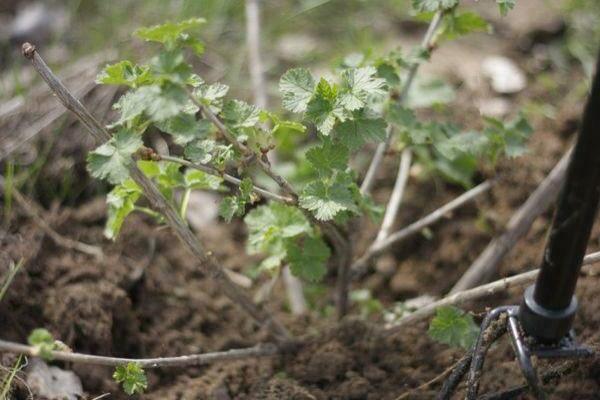
English yellow gooseberry: photo of the variety
For propagation of the gooseberry variety English yellow, as a rule, the following most popular methods are most often used:
- cuttings;
- using layering;
- dividing the bushes.
Cuttings Is a very popular and effective way of growing gooseberries. To obtain an excellent effect, cut off middle-aged shoots with a tough bark. After that, they are separated into parts. Then these parts are germinated. This method allows you to get an unlimited number of seedlings.
Horizontal layering - this method is suitable for plants that are more than 3 years old. One mother plant is capable of producing at least 5 young shoots. Which, by the way, do not lose the original taste and quality characteristics of the mother material.
Division of bushes usually produced in autumn, but also in early spring. To do this, the bush is divided into 3 parts, after which each part is rooted. The survival rate is very high.
All of these methods are effective. Choose the one you like best. All varietal characteristics of the parental original material are preserved during the propagation of gooseberries.
How to plant and care for gooseberries
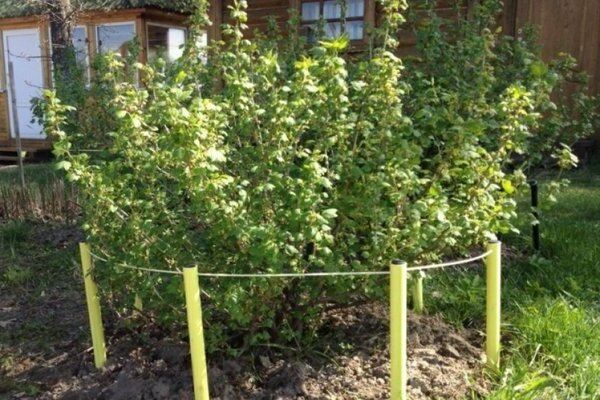
English yellow gooseberry: photo of the variety
English yellow gooseberries are usually planted in the spring after the snow has melted. This is around the end of March. Also, many gardeners plant a plant in the fall, before the arrival of the first autumn frosts - until October.
When choosing a soil, preference should be given to loose and fertile black soil, as well as loamy soil. Gooseberries should never be planted in acidic soil. The acidity level should be either neutral or at a minimum.
Also, avoid places where groundwater is close to the surface. Since waterlogging negatively affects the growth and development of culture. The place should be sunny, bright, without drafts.
Before planting gooseberries, fertilizers (mullein and ash) are introduced into the ground for a month and the plot is dug up. At the time of planting, a mixture of superphosphate with turf is introduced into the hole, after which the plant is already rooted.
For planting, choose seedlings at least two years old. They should have at least a couple of shoots with hard bark. Be sure to check the integrity of the bark. There should be no defects on it. We select shoots with a whole, smooth shell.
At the same time, the root system must be branched; healthy, strong planting material is needed.
When planting English yellow gooseberries, follow the sequence below:
- To begin with, we dig a hole, the size of which is about 50x50 cm;
- Next, fill the hole 1/3 with a mixture of earth with mineral fertilizers. At the same time, forming a hill;
- Then we put the seedling on the top of the slide. The roots are free:
- The root collar is not deepened. It should be flush with the soil or one centimeter higher;
- The root system is sprinkled with black soil, tamping it;
- The gooseberries are thoroughly watered;
- After watering, the ground is mulched, and the shoots are cut off about a sixth bud from the base.
A week later, the gooseberries are watered again, and the ground is mulched with sawdust.
Growing features
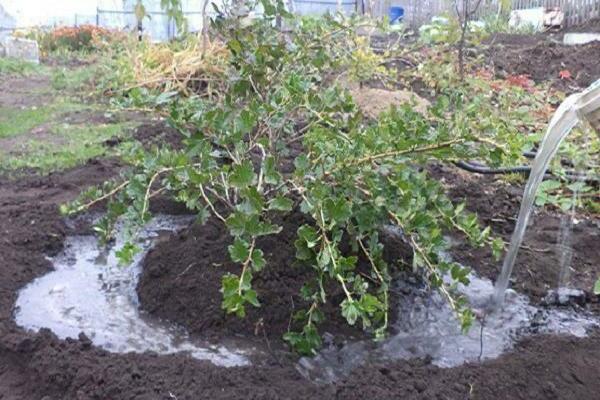
When growing English gooseberries, pay attention to the fact that it must be trimmed in the fall (when the foliage has fallen) or in the spring (before the bud swelling phase).
If the plant is planted the first year, then it must be cut by 1/3. In this case, the height of the shoots should be at least level 5 buds. All basal processes are removed. The strongest and strongest processes are left.
Such care is required during the first seven years of a gooseberry's life. After that, the plant is rejuvenated. All old shoots are removed, and new ones are cut by 1/3. Also, its height should be at the level of the fifth kidney.
Please note that it is necessary to water the plant using a ditch, which is dug around the perimeter of the bush 50 cm from the base, while the depth of the ditch is not more than 15 cm.
If your gooseberry is less than three years old, then 2 buckets of liquid will suffice. If more than 3 years old, then it is taken at the rate of 4 buckets of water per 1 bush.
It is necessary to water the plant three times a year. First times - late May-early June. Second times - mid-July. Third time - before the onset of frost - end of September. It is not necessary to water the plant more often, because, as mentioned earlier, it is afraid of waterlogging.
After planting the plant, it is not necessary to feed it for the first three years of its life. Then they are fed about 3 times a year:
- the first time around April. Before the buds bloom. For this, ammonium nitrate is introduced in a circle near the base;
- the second time - after the flowering phase has ended. The plant is watered with superphosphate;
- the third time - after all the foliage has fallen. They bring in rotted manure and dig up the ground.
In order for the plant to receive more sunlight, the branches are attached to the trellis in the form of a fan. The bush is shortened and left 60 cm, after which it is tied to a support.
In order to avoid attacks of rodents, they dig the earth around the trunk of the English gooseberry and remove the weeds. This allows possible burrows to be destroyed. In the fall, the gooseberry is covered with spruce branches. They will protect the plant from unwanted rodents.
Before winter, the English yellow gooseberry is tied in one bunch and bent to the ground. After that, a "hut" of boards is built or branches are laid. Next, any covering sheet is thrown and fixed.
Diseases and pests, how to deal with them
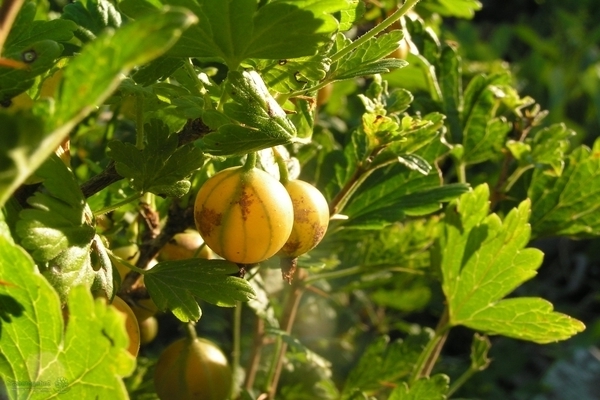
English yellow gooseberry: photo of the variety
English yellow gooseberries are resistant to almost all diseases, but powdery mildew is not on the list. For prevention, it is recommended in the spring, before the buds bloom, to treat the bush with Nitrafen.
Also, after each pruning, the branches are treated with Bordeaux liquid. After the plant has been watered, be sure to dig up the soil. Get rid of weeds and fallen leaves in the fall.
Gooseberries of this variety are susceptible to attacks by aphids, moths and spider mites. It is easier to prevent and treat the plant with Karbofes than to fight pests. Be sure to destroy fallen leaves and dead plant parts, and re-treat the plant with Karbofes in the summer.
Gooseberry English yellow: reviews of gardeners
The English yellow gooseberry is a very tasty berry with an excellent, high yield. The plant does not require special care, it is very easy to grow it - which even the most inexperienced gardener can handle.
Following all the simple recommendations and creating the most favorable conditions for the growth of the English gooseberry. You can collect about 15 kg of berries from one plant, which not only have an excellent taste and presentation, but are also well stored and transported.
Reviews about English yellow gooseberries
Svetlana Vasilievna Kotova, 58 years old, Suzdal
A long time ago, I asked a friend for an English yellow gooseberry shoot, I really liked her. It took root perfectly, after a couple of years I harvested my first crop and was delighted. The taste is honey, by the way, its color is also honey. Since then, gooseberries make me happy every year with their appearance and wonderful taste of berries.
Victor Stepanovich Porsin, 47 years old, Rostov-on-Don
I grow English yellow gooseberries for sale. There have never been any problems with transportation. In the market, no one will ever pass by my berries. First they "taste" and then buy. The berry is large, beautiful, juicy, and also shines - everything we love.
Stanislav Vasilievich Rubtsov, 40 years old, Vladikavkaz
I grow English yellow gooseberries in the country, so there is no special time to take care of it. I water it a couple of times over the summer and cut it off in the spring - I don't do anything else. His unpretentiousness initially bribed me. When the first harvest appeared, my wife and I were delighted, very tasty berries. My wife cooks compote from the English yellow gooseberry variety and jam, I share the wine - everything is very tasty.


